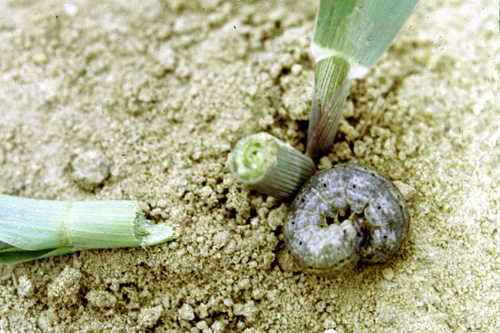Cutworms in the vegetable garden
Snipped transplants and seedlings are the clue that you’ve got cutworms. Consider these non-pesticide solutions to protect your garden from this pest.
“I walked out to my vegetable garden this morning and four small tomato transplants were just lying on the ground. The stems were cleanly cut off on a diagonal just above the soil line.”
This statement, or a variation of it, is often heard across Michigan in the spring when newly transplanted vegetable plants or tender seedlings are coming up in the garden. The list of usual suspects is short: cutworms. They live up to their name and are the guilty party. If larger animal pests were the bad guys, the entire plant would be missing.
Cutworms are the larval or juvenile form of several kinds of night-flying moths. The adult moths do no damage – the larvae do. Some cutworms feed at night at the soil line, some feed just below the soil, and some climb into the plant and feed there. A cutworm curls its body around the stem and feeds on it, cutting it off at just about the soil surface. During the day, cutworms hide in plant debris and wait for the evening’s banquet. New transplants have tender stems, especially if they have just been put into the garden. These stems get tougher with age and growth. Some directly seeded plants, like green beans, can also be clipped off.

Cutworms can be controlled with several non-pesticide solutions. Pesticides are often unsuccessful. A gardener might try one or multiple techniques to lessen plant losses. Cutworms are seeking shade, plant debris, damp soil and tender stems. The smart gardener will seek to block their requirements.
- Mow up to the edge of the garden so cutworms have less to feed on surrounding the garden.
- Keep a 3- or 4-foot strip of dry soil with no plants around the entire perimeter so the garden is unattractive to enter.
- Plant sunflowers as a trap crop around the perimeter and hunt and kill cutworms daily. This is a favored food. But the “seek and destroy” mission must be regular or the cutworms will increase in number because they are being fed.
- Surround tender transplant stems with collars of folded newspaper, cardboard strips or aluminum foil. The collars should be 2 to 3 inches tall and pushed firmly into the soil or the cutworm can’t go over or under. Cutworms cannot curl around those stems. Paper collars can stay in place until they break down. The foil should then be removed.
- Do not plant cover crops or green manure crops in the garden until the cutworm problem is under control. These are crops like rye, buckwheat and clover. The plants are grown and tilled into the soil to add organic content, but also provide food for cutworms when growing. Instead, add compost or composted manure to boost organic matter.
- Avoid the use of organic mulch down the aisle ways because it gives cutworms hiding places. Instead, use a method called “dust mulching.” Till or hoe about 1 inch deep so the surface dries out and is fluffy, but what is below stays damp. Cutworms do not like crawling in dry soil.
- Water early in the day and loosen soil shortly thereafter so the soil surface is dry by evening or cutworm dinnertime.
Keep in mind that some gardeners will never have cutworm problems while others may occasionally have them, but it would be unusual to continually have cutworm damage if these preventative measures are taken.



 Print
Print Email
Email